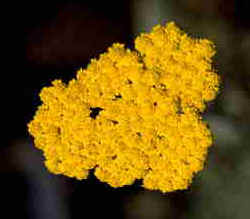Achilles, Yarrow, "Coronation Gold"

-
Perennial
-
Hardiness zones: 4 to 9
-
Season of Bloom: June to Sept.
-
Height x Width: 2' to 3.5' x 2' to 3'
-
Color: Golden Yellow
-
Light: Full Sun
-
Soil Environment: Average to poor,
-
well drained soil
The best of
all the Yarrow's. It's silvery-green fernlike foliage adds a subtle injection
of color to the garden. It's blooms are a bright yellow and form in flat
topped clusters. Any Gardener will be happy with this flower in his or her
Garden. On top of all this, Coronation Gold is especially suited for the
Kansas City area. It is drought tolerant, which, helps it endure the months of
July and August and it prefers a well drained soil, but doesn't mind being
watered. (don't over water). Insect's don't bother Coronation Gold, which,
places this plant in the low maintenance category. On the other hand, fungus
can appear on the foliage starting around mid-summer. It has the effect, of
making the foliage a bit rangy, but it doesn't seem to affect the blooms. You
may want to apply a fungicide to keep the foliage looking presentable. If you
do apply a fungicide, I would recommend that you do it as a preventative. In
other words, apply it before any fungus becomes a problem. If you wait until
the fungus appears, it may take a long time before the fungicide becomes
effective ( possibly towards the end of the growing season). Around
mid-summer, and after the first blooms are exhausted, I will usually cut
Coronation Gold back to promote a second bloom period. I have found that
dead-heading each bloom doesn't seem to encourage an immediate rebloom as does
with some perennials. Something else, Coronation Gold doesn't seem to be prone
to flopping over as most Yarrow's do. As compared with other Yarrow's , the
stems are very sturdy, this makes Coronation Gold a great cut flower, and it
can be dried for decorative uses.
Complimentary Plants to go with Coronation Gold.
Coronation Gold,
essentially has two colors associated with it. First, the foliage silvery
green. The second, of course is the flower color, which is yellow. This would
suggest to create a color harmony, any flowers with a red, orange and yellow
bloom would probably work well with Coronation Gold. Also, the complimentary
color for Coronation Gold is violet. Below are suggestions of plants that
should work well together with Coronation Gold in the Kansas City climate
(zone 5).
Complimentary
Flowers
Red blooming -St. John's Fire Salvia, Lady in Red Salvia (
both annuals), Geranium (annual), Maltese Cross (H2O), Red Valerian,
Gaillardia (red/yellow blooms, be prepared to spend time deadheading (blooms
profusely)).
Orange blooming - Cosmos (Cosmic Series (annual)), California
Poppy (annual).
Yellow blooming - Cosmos (Cosmic Series (annual)), Coreopsis
(any), Black-eyed Susan.
Violet blooming - Monch Aster, Catchfly Electra (Biennial),
Veronica, Purple Coneflower, Lavender, May Night Salvia, Cupid's Dart
(Biennial), Liatris, Russian Sage and Lythrum.
Complimentary plants based on foliage - Artemisia (highly
recommended), burgundy Canna's (H2O), Sea Holly, Smoke Bush,
Chocolate Joe Pye weed(H20).
|

